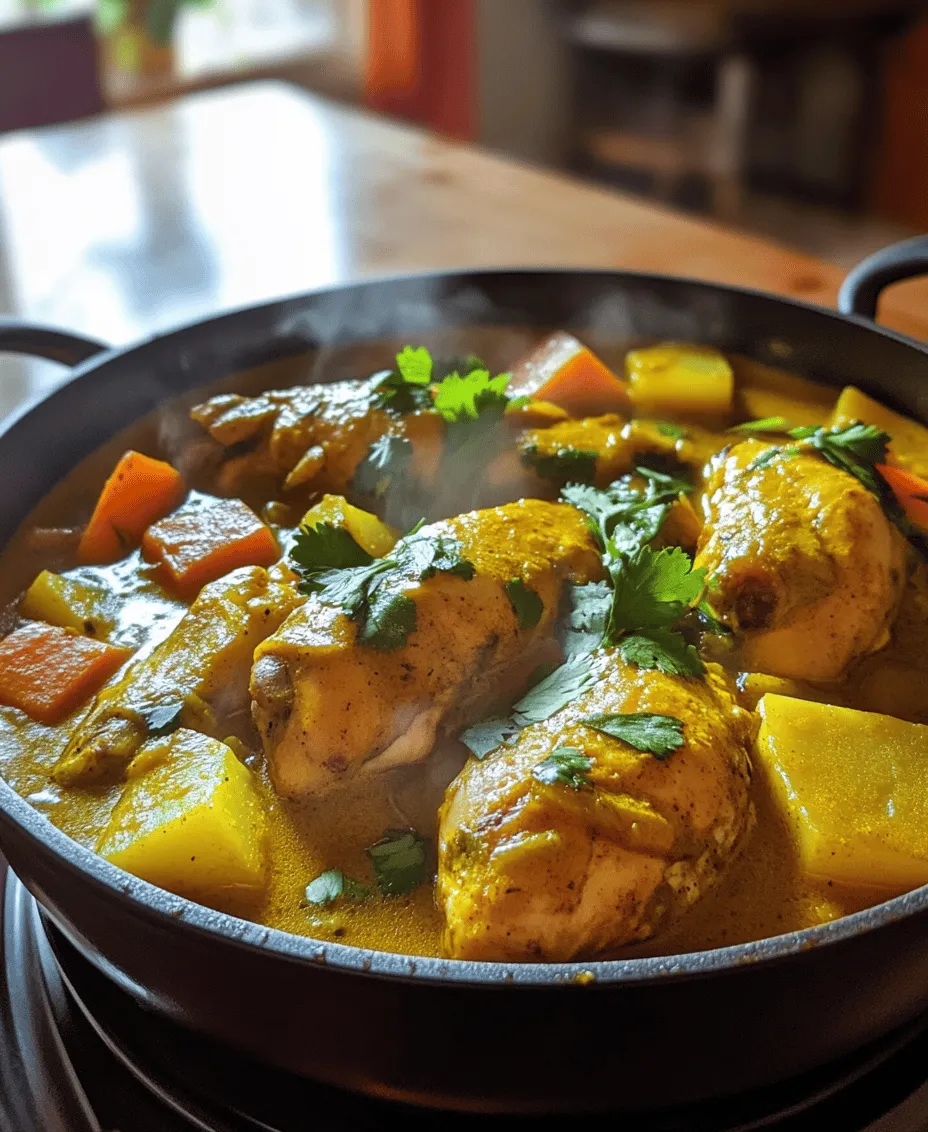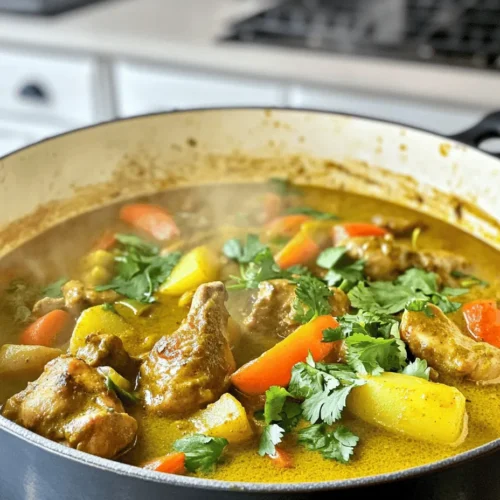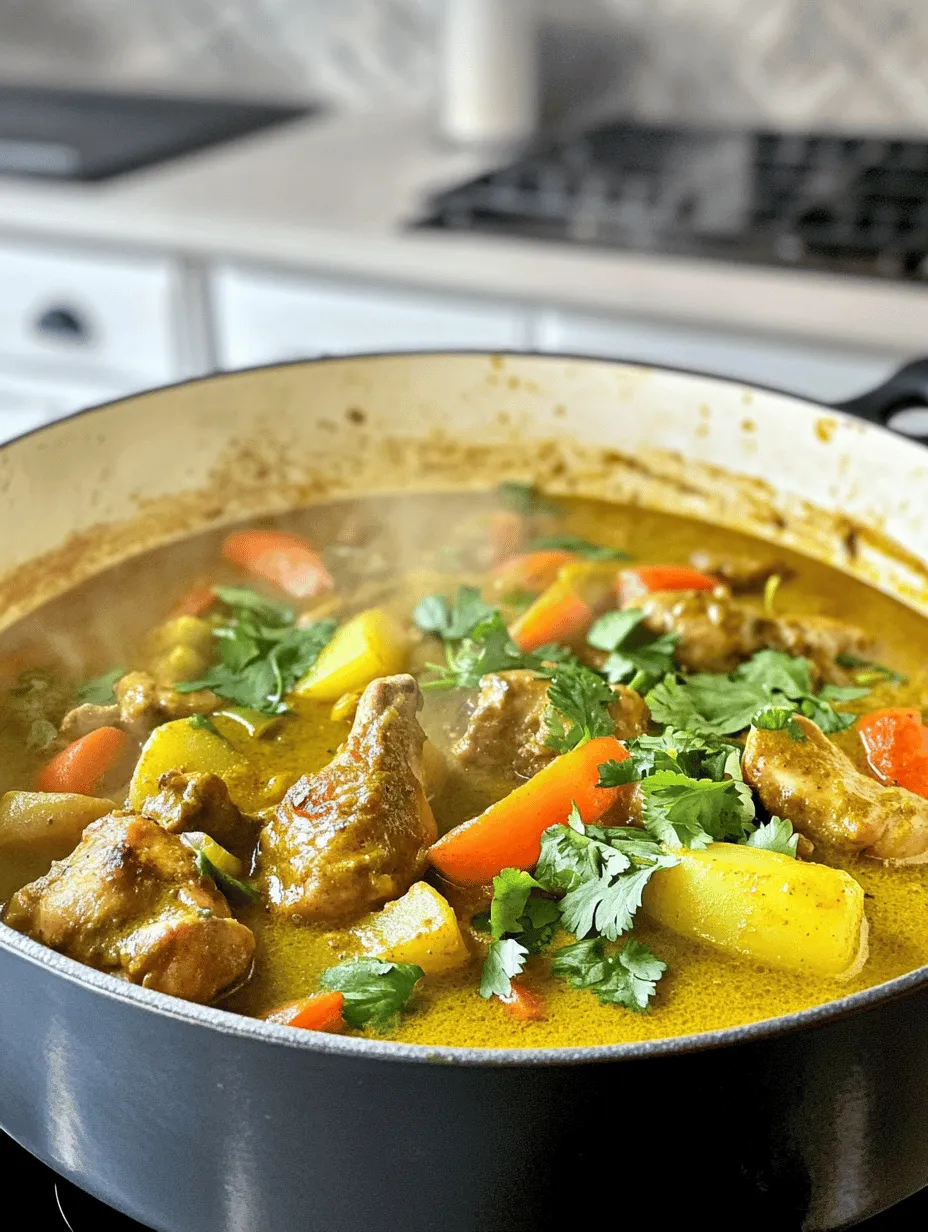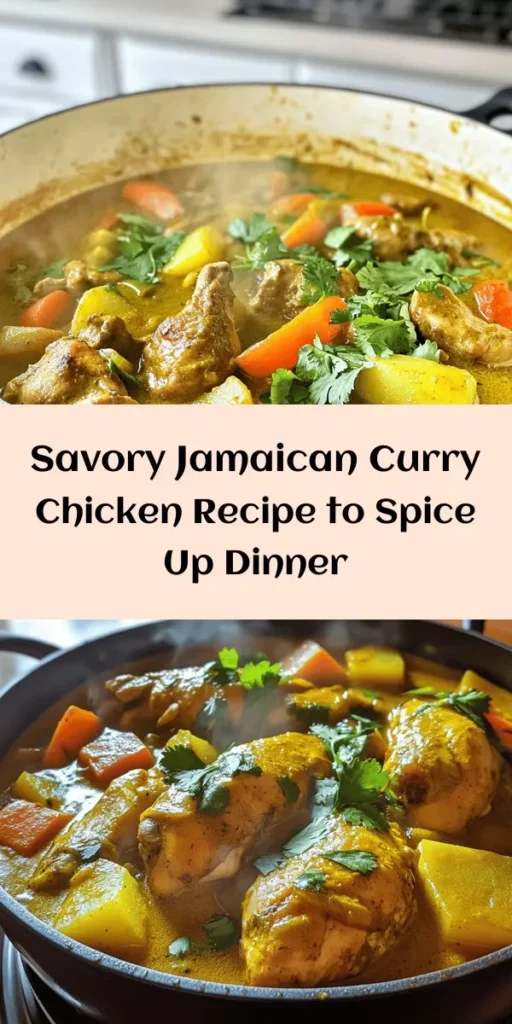Explore the vibrant world of Jamaican cuisine with this Authentic Jamaican Curry Chicken recipe, a dish that embodies the rich flavors and culinary traditions of the Caribbean. Known for its bold spices and hearty ingredients, this curry chicken is a staple in Jamaican households, celebrated for its depth of flavor and comforting qualities. Whether you’re seeking a new family favorite or looking to impress guests, this recipe is sure to deliver an unforgettable dining experience.
Understanding Jamaican Curry
The Essence of Jamaican Curry
The history of curry in Jamaican cuisine is deeply intertwined with the island’s colonial past and diverse cultural influences. Originally brought to the Caribbean by Indian indentured laborers in the 19th century, curry quickly became integrated into the local culinary landscape. Over time, it evolved, adopting unique flavors and techniques that reflect the island’s rich heritage. Jamaican curry is distinct for its bright yellow hue, which comes from turmeric, and its aromatic profile that sets it apart from other curry varieties.
At the heart of Jamaican curry is the signature spice blend known as Jamaican curry powder, a mix of spices that can vary by region and household. The key ingredients typically include turmeric, cumin, coriander, fenugreek, and black pepper, all working in harmony to create a warm and inviting flavor. However, one spice that stands out in Jamaican cooking is allspice (known locally as pimento), which adds a unique sweetness and depth to the dish. The inclusion of allspice is a defining characteristic of Jamaican curry, giving it a flavor profile that is both complex and comforting.
Ingredients Breakdown
Essential Components of Authentic Jamaican Curry Chicken
To achieve the authentic taste and texture of Jamaican curry chicken, it is crucial to select the right ingredients. Each component plays a significant role in the overall flavor, making it essential to understand their importance.
– Chicken: The choice of chicken cut can greatly affect the outcome of your curry. For the best flavor and texture, bone-in, skin-on pieces are recommended, as they provide richness and depth during cooking. Common choices include chicken thighs and drumsticks, which remain moist and tender throughout the cooking process.
– Spices: The heart of any good curry lies in its spices. Jamaican curry powder is essential for this recipe, providing the primary flavor base. Additionally, including freshly ground black pepper, cumin, and coriander can elevate the dish. Don’t forget to add allspice, which is a fundamental spice in Jamaican cooking, known for its warm and aromatic qualities.
– Aromatics: Garlic, ginger, and onion are the aromatics that will build the flavor foundation of your curry. Fresh garlic and ginger add a zesty kick, while onion provides sweetness and depth. These ingredients are typically sautéed at the beginning of the cooking process to release their natural oils and flavors.
– Vegetables: Enhancing your curry with vegetables not only adds nutritional value but also contributes to the dish’s overall texture. Carrots, potatoes, and bell peppers are popular choices, providing sweetness and crunch that balances the rich, spicy flavors of the curry.
– Scotch Bonnet Peppers: Known for their fiery heat, Scotch bonnet peppers are a hallmark of Jamaican cuisine. Their unique flavor complements the spices in the curry and adds a layer of complexity. If you’re sensitive to heat, you can adjust the amount used, or remove the seeds to make the dish milder.
– Coconut Milk: To achieve a creamy and rich sauce, coconut milk is an essential ingredient in this recipe. It not only adds depth but also balances the spiciness of the curry, making it a harmonious dish.
Preparation Steps for the Perfect Curry Chicken
Marinating the Chicken
One of the most crucial steps in preparing authentic Jamaican curry chicken is marinating the chicken. Marination enhances the flavor and tenderizes the meat, ensuring every bite is packed with the essence of the spices. For optimal results, it is recommended to marinate the chicken for at least 2 hours, but overnight is ideal if time permits. This allows the spices to penetrate deeply into the meat, resulting in a more flavorful dish.
To prepare the marinade, combine Jamaican curry powder, garlic, ginger, salt, and a splash of lime juice in a bowl. Coat the chicken pieces thoroughly with this mixture, ensuring each piece is well-covered. Cover the bowl with plastic wrap and place it in the refrigerator to allow the flavors to develop.
Searing the Chicken
After marinating, the next step is to sear the chicken. Searing not only locks in moisture but also adds a beautiful golden-brown color that enhances the dish’s visual appeal. To achieve the perfect sear, heat a large, heavy-bottomed skillet or Dutch oven over medium-high heat and add a tablespoon of oil.
Once the oil is hot, carefully add the marinated chicken pieces, ensuring not to overcrowd the pan. Overcrowding can lead to steaming rather than searing, which will affect the texture of the chicken. Sear the chicken on each side for about 5-7 minutes or until golden brown. Once seared, remove the chicken from the pan and set it aside. This step is crucial for building flavor, as the browned bits left in the pan will form the base of the curry sauce.
Incorporating Vegetables
With the chicken seared to perfection, it’s time to incorporate the vegetables. Start by adding diced onions to the same pan, scraping up any browned bits from the bottom. Sauté the onions for about 2-3 minutes until they become translucent, followed by minced garlic and ginger. This combination will create a fragrant base for your curry.
Next, add in the carrots and potatoes, allowing them to cook for a few minutes before adding the seared chicken back to the pan. This timing is essential to maintain the texture of the vegetables while ensuring they absorb the flavors of the curry. Stir everything together, allowing the chicken to mingle with the vegetables and aromatics.
As you continue to build the dish, don’t forget to add the Scotch bonnet pepper. You can either leave it whole for a milder heat or slice it to release more spice into the curry. Finally, pour in the coconut milk, stirring to combine all the ingredients. The coconut milk will create a luscious sauce that envelops the chicken and vegetables while balancing the heat from the spices.
By following these initial preparation steps, you are well on your way to creating a delicious and authentic Jamaican curry chicken. The combination of marination, searing, and careful incorporation of vegetables will ensure a rich, hearty dish that reflects the vibrant flavors of Jamaica.

How Vegetables Enhance the Overall Flavor Profile
In Jamaican Curry Chicken, the addition of vegetables plays a pivotal role in creating a well-rounded flavor profile that enhances the dish. Traditional vegetables like bell peppers, onions, and carrots not only add vibrant colors to the plate but also contribute essential nutrients and textures. The sweetness of bell peppers contrasts beautifully with the spiciness of the curry, while onions bring a depth of flavor that sweetens as they caramelize during cooking. Carrots provide a subtle earthiness that balances the overall seasoning of the dish.
Moreover, including vegetables in your curry chicken allows for a more complex flavor experience. The natural sugars released from the vegetables during the cooking process help to meld the spices and create a rich sauce. This layering of flavors is essential in authentic Jamaican cooking, where the goal is to create a dish that is both satisfying and bursting with taste.
Adding Liquids: Broth and Coconut Milk
For an authentic Jamaican Curry Chicken, the balance of liquids is crucial in achieving the perfect sauce. The two primary liquids used are chicken broth and coconut milk. Chicken broth adds depth and umami flavor, while coconut milk brings a creamy sweetness that complements the spices beautifully.
To achieve the ideal sauce consistency, you’ll want to find the right ratio of broth to coconut milk. A good starting point is to use equal parts of both, adjusting as needed based on your personal taste preferences. If you prefer a richer sauce, you may lean towards more coconut milk. Conversely, if you want a lighter curry, increase the amount of broth.
When cooking, it’s important to adjust the liquid levels depending on your desired consistency. If the curry seems too thick, a splash of broth or water can help loosen it up. On the other hand, if the sauce is too thin, you can let it simmer uncovered for a few additional minutes to allow some of the liquid to evaporate and thicken the sauce naturally.
Simmering to Perfection
Simmering is a critical step in preparing Jamaican Curry Chicken, as it allows the chicken to become tender and the flavors to meld beautifully. The science behind simmering lies in the gentle heat that promotes even cooking without making the chicken tough. When chicken is cooked at a rolling boil, the proteins can seize up, resulting in a dry texture. Instead, by simmering on low heat, you create a moist environment that keeps the chicken juicy.
To maintain even cooking and avoid sticking, ensure that you stir the curry occasionally. This not only helps prevent the chicken from clinging to the bottom of the pot but also ensures that the flavors from the spices and vegetables are evenly distributed throughout the dish. A well-simmered curry can take anywhere from 30 to 45 minutes, depending on the size of your chicken pieces, so patience is key.
Adjusting the Sauce Consistency
Achieving the desired thickness for your sauce can make all the difference in the final dish. Here are some techniques for adjusting the sauce consistency:
Tips for Reducing Sauce if Too Thin
If you find that your curry sauce is too thin, allow it to simmer uncovered. This evaporation process will concentrate the flavors and thicken the sauce. A cornstarch slurry (a mixture of cornstarch and cold water) can also be used to thicken the sauce quickly. Simply mix one tablespoon of cornstarch with two tablespoons of water and stir it into the curry. Allow it to simmer for a few minutes until the sauce has thickened.
How to Adjust if the Sauce is Too Thick
Conversely, if your sauce has become too thick, you can add a bit of broth or water to loosen it. Start with a small amount and stir well, allowing the liquid to integrate fully before adding more. Remember that a little goes a long way, so adjust gradually until you reach the desired consistency.
Final Touches and Serving Suggestions
As you near the end of your cooking process, it’s time for the final touches that will elevate your Jamaican Curry Chicken.
Finishing Up the Dish
Before serving, it’s essential to taste-test the curry for seasoning adjustments. Depending on your palate, you may want to add a pinch more salt or a squeeze of lime juice to brighten the flavors. Garnishing with fresh herbs, such as chopped cilantro or green onions, can enhance the presentation and add a burst of freshness.
Recommended Garnishes for Enhanced Presentation
For a beautiful finish, consider topping your curry with slices of fresh avocado or a dollop of sour cream. These additions not only look appealing but also provide a creamy contrast to the spices in the dish. Serving with a wedge of lime on the side allows diners to customize their flavor experience.
Pairing Your Jamaican Curry Chicken
To fully enjoy your Jamaican Curry Chicken, consider pairing it with traditional side dishes and beverages that complement the meal.
Traditional Side Dishes: Rice and Peas, Plantains, and More
The quintessential pairing for Jamaican Curry Chicken is rice and peas, a dish made with rice cooked in coconut milk and seasoned with thyme and scallions. This side perfectly balances the richness of the curry. Fried plantains also make for a delicious accompaniment, offering a sweet contrast to the savory flavors of the dish.
For a lighter option, a simple mixed greens salad dressed with a tangy vinaigrette can cleanse the palate between bites of the rich curry.
Beverage Pairings to Complement the Meal
When it comes to beverages, consider serving your curry chicken with a refreshing drink. A cold glass of ginger beer or a fruity rum punch can enhance the tropical vibe of the meal. For those who prefer non-alcoholic options, coconut water is a perfect choice to keep with the island theme.
Cultural Significance of Jamaican Curry Chicken
Jamaican Curry Chicken is not just a dish; it represents a rich cultural tradition steeped in history.
Celebrations and Gatherings Where Curry Chicken is Served
In Jamaica, curry chicken is often featured at family gatherings, celebrations, and holidays. It’s a dish that brings people together, symbolizing hospitality and community. Whether it’s a Sunday dinner or a festive occasion, serving curry chicken is a way to share love and culture with family and friends.
Personal Anecdotes from Jamaican Culinary Traditions
Many Jamaicans have childhood memories of their grandparents cooking curry chicken in the kitchen, filling the house with tantalizing aromas. These culinary traditions are passed down through generations, preserving the essence of Jamaican culture and creating a sense of belonging. Cooking this dish can evoke those cherished memories, connecting you to a broader heritage.
Conclusion: Savoring the Flavors of Jamaica
In conclusion, Authentic Jamaican Curry Chicken offers a delightful journey through the flavors and traditions that characterize Jamaican cuisine. This dish not only nourishes the body but also connects us to the rich cultural heritage of the Caribbean. By following this recipe, you can bring the vibrant essence of Jamaica into your kitchen, allowing you and your loved ones to enjoy a taste of this iconic dish. Embrace the experience of cooking, savor the flavors, and enjoy every bite of this delicious curry chicken. Whether served at a family dinner or a festive gathering, this dish is sure to leave a lasting impression on all who partake.



